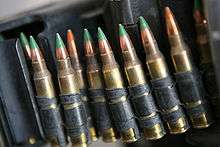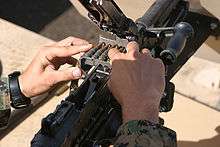Belt (firearms)
- "Shot belt" or "ammunition belt" can also refer to a belt that a person wears, with loops for inserting ammunition cartridges.



A belt or ammunition belt is a device used to retain and feed cartridges into a firearm. Belts and the associated feed systems are typically employed to feed machine guns or other automatic weapons. Belt-fed systems minimize the proportional weight of the ammunition to the feeding device along with allowing high rates of continuous fire.
Arguably, precursors to the belt-fed machine gun were the Cass rifle, patented in 1848, and the Treeby chain gun, patented in the 1850s.[1] Belts were originally composed of canvas or cloth with pockets spaced evenly to allow the belt to be mechanically fed into the gun. These designs were prone to malfunctions due to the effects of oil and other contaminants altering the belt. Later belt designs used permanently connected metal links to retain the cartridges during feeding. These belts were more tolerant to exposure to solvents and oil. Many weapons designed to use non-disintegrating or canvas belts are provided with machines to automatically reload these belts with loose rounds or rounds held in stripper clips. In use during World War I, reloaders allowed ammunition belts to be recycled quickly to allow practically continuous fire.
Many modern ammunition belts use disintegrating links. Disintegrating links retain a single round and are articulated with the round ahead of it in the belt. When the round ahead is stripped from the belt and fed into the feed system or chamber, the link holding it is ejected and the link holding the following round is disarticulated.
Modern infantry machine guns often have feed systems allowing the use of linked ammunition or other forms of feed like magazines or drums. In some instances—like the FN MINIMI/M249 SAW and the IMI Negev—the feed system requires no modification to fire with either mechanism. Other designs—like the Heckler and Koch HK21-based designs or MG34—require the exchange of modular parts to allow belt or alternate feeding. Due to the lack of protection provided by the belt, belt-fed infantry weapons typically use a flexible or rigid container to retain the belt on the weapon. In some designs—like the MG3—the belt container appears to be a magazine causing some confusion to people unfamiliar with the design. The capacity of belts and carriers is typically a function of weight and bulk. Their size is limited by caliber and the portability of the combined weapon and ammunition. The most common sizes typically carried on a man-portable weapon run from 50 to 300 rounds.
Feed variants
Pull out - Push through
Found on mostly early machine guns. The pull out - push through cartridge feed system has the cartridge withdrawn from the belt to the rear, then pushed directly forward into the barrel. Examples are the Darne mle 1922, Browning 1919, Browning M2HB, Maxim and Vickers. Among the modern machine guns using this system are the PK family, where its use is mandated by the rim of the 7.62×54mmR cartridge, which makes it all but impossible to eject the round forward from the belt.
Push through
Found on mostly modern machine guns. The push through cartridge feed system has the cartridge pushed directly forward into the barrel.
External
Some weapons such as the M134 Minigun and related designs use a hybrid mechanism to strip rounds from disintegrating belts into a linkless feed system or a specialized delinker to allow for more reliable feeding at extreme rates of fire.
See also
| Wikimedia Commons has media related to Ammunition belts. |